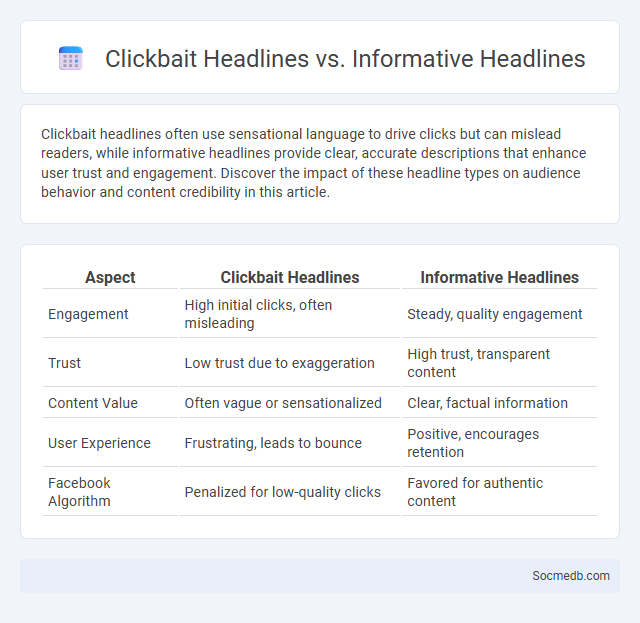
Photo illustration: Clickbait headlines vs informative headlines
Clickbait headlines often use sensational language to drive clicks but can mislead readers, while informative headlines provide clear, accurate descriptions that enhance user trust and engagement. Discover the impact of these headline types on audience behavior and content credibility in this article.
Table of Comparison
| Aspect | Clickbait Headlines | Informative Headlines |
|---|---|---|
| Engagement | High initial clicks, often misleading | Steady, quality engagement |
| Trust | Low trust due to exaggeration | High trust, transparent content |
| Content Value | Often vague or sensationalized | Clear, factual information |
| User Experience | Frustrating, leads to bounce | Positive, encourages retention |
| Facebook Algorithm | Penalized for low-quality clicks | Favored for authentic content |
Understanding Clickbait Headlines: Definition and Purpose
Clickbait headlines are designed to attract attention and generate clicks by using sensational or misleading language that sparks curiosity. Their primary purpose is to increase website traffic and improve ad revenue by compelling users to engage with content. Understanding these tactics helps you critically evaluate online information and avoid being misled by exaggerated claims.
What Makes a Headline Informative? Key Elements
A headline becomes informative by clearly conveying the main idea while incorporating relevant keywords that resonate with the target audience. Essential elements include specificity, which provides concrete details, and clarity, ensuring the message is easily understood without ambiguity. Effective headlines also incite curiosity or highlight benefits, driving higher engagement and click-through rates on social media platforms.
Clickbait vs Informative Headlines: Core Differences
Clickbait headlines prioritize grabbing Your attention through sensationalism and curiosity gaps, often leading to misleading or exaggerated content. Informative headlines focus on clarity and accuracy, providing a truthful summary of the article's content that builds trust and credibility. Understanding the core differences helps You discern valuable content from manipulative marketing strategies on social media platforms.
Psychological Triggers Behind Clickbait Headlines
Clickbait headlines exploit psychological triggers such as curiosity gaps, fear of missing out (FOMO), and emotional arousal to compel users to click. These headlines use sensational language and incomplete information, prompting your brain to seek closure and engage with the content. Understanding these triggers can help you recognize and avoid manipulative social media tactics designed to capture your attention.
Impact of Clickbait on Reader Trust and Engagement
Clickbait headlines undermine reader trust by exaggerating or misrepresenting content, leading to decreased credibility and skepticism toward social media platforms. Studies indicate that engagement initially spikes due to curiosity clicks but often drops as users feel deceived, reducing long-term interaction. Persistent use of clickbait erodes the quality of user experience, harming brand reputation and diminishing audience loyalty on platforms like Facebook and Twitter.
SEO Implications: Clickbait Headlines vs Informative Headlines
Clickbait headlines often generate high initial click rates but can harm your website's SEO by increasing bounce rates and reducing user trust. Informative headlines, enriched with relevant keywords, enhance search engine rankings by providing clear, valuable content that satisfies user intent. Balancing engagement with accurate titles improves your content's credibility and long-term visibility on search engines.
Measuring Content Performance: Clickbait vs Informative Headlines
Measuring content performance on social media requires analyzing metrics such as click-through rates, engagement time, and audience retention to compare clickbait and informative headlines. While clickbait headlines may generate higher initial clicks, informative headlines typically foster greater trust, deeper engagement, and long-term follower loyalty. You should prioritize headline strategies that balance intrigue with value to optimize content impact and audience growth.
Risks and Ethical Concerns of Using Clickbait
Using clickbait on social media poses significant risks including the spread of misinformation, erosion of user trust, and manipulation of audience emotions for engagement. Clickbait often distorts facts and prioritizes sensationalism over accuracy, leading to ethical concerns about transparency and honesty in digital communication. Your credibility can suffer as users become wary of misleading headlines, impacting long-term relationships with your audience.
Best Practices for Crafting Informative, High-Performing Headlines
Creating informative, high-performing headlines on social media involves using clear, concise language that highlights the key value or benefit to your audience. Incorporate relevant keywords and action verbs to boost engagement and improve searchability across platforms. Your headline should immediately capture attention and encourage clicks by promising specific, valuable information tailored to your audience's interests.
Future Trends: The Evolving Role of Headlines in Digital Content
Headlines in digital content are becoming increasingly personalized through AI-driven algorithms that analyze user behavior and preferences to boost engagement and click-through rates. Emerging trends highlight the integration of interactive elements within headlines, such as emojis and dynamic questions, to capture audience attention faster. Voice search optimization and mobile-first design are reshaping headline strategies, ensuring content remains accessible and compelling across diverse devices and platforms.
 socmedb.com
socmedb.com